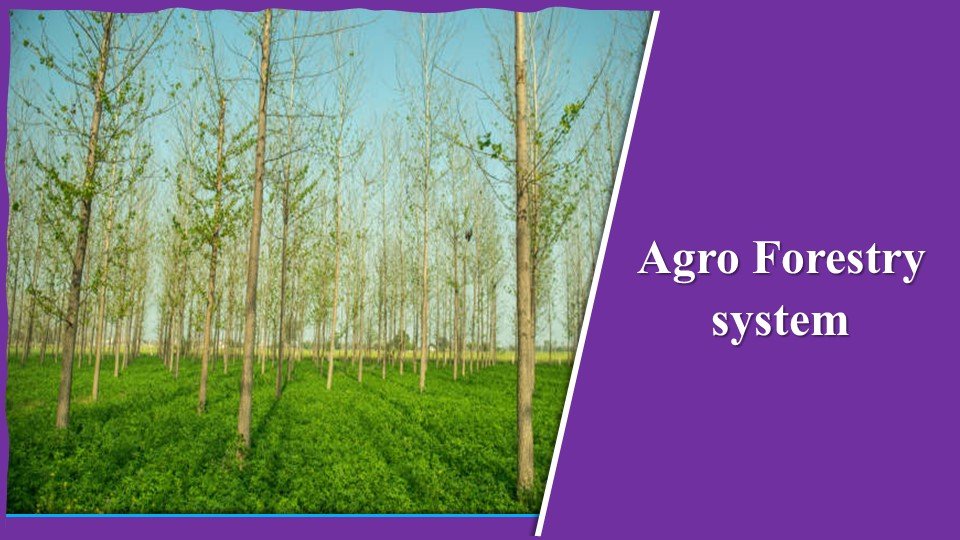Agro Forestry system

In this article we will covered agro forestry system in India, these system includes different types of agro forestry that commonly used in India. Agro Forestry is an age-old practice in which arable crops and trees are grown together. Agro-forestry is a collective term for land-use system, in which wood perennials (trees/shrubs or both) are deliberately combined with crops on the same land-management unit as crops and or animals, either in some form of spatial arrangement or in time sequence. An ideal agro- forestry system would result in sustainable increase in overall production, using management practices compatible with social, cultural and economic conditions of the local population.
Agro forestry System
Several agro forestry system found in the country that are listed below:
1-Agri-silviculture system
It refers to conscious and deliberate use of land for the concurrent production of agricultural crops (including tree crops) and forest crops.
2-Silvi-pastoral system
The land management systems in which forests are managed for the production of wood as well as for the rearing domesticated animals. In this system the animals are kept and permitted to graze within the forests. not-mp4.20.ells
3-Agri-silvi-pastoral system
The system in which land is managed for the concurrent production of agricultural and forest crops and for rearing of domesticated animals. This system is a combination of agri-silvi- culture and silvi-pastoral systems.
4-Multi-purpose forest-tree production – system
Here the forest- tree species are regenerated and managed for their ability to produce not only wood, but – leaves or fruits that are suitable for food or fodder.
5-Alley cropping
Alley cropping is -essentially an agro-forestry system, in which food crops are grown in alleys formed by hedge rows of trees or shrubs. The hedge rows are cut back at planting and kept pruned during the cropping seasons to prevent shading and to reduce competition with food crops. When there are no crops, the hedge rows are allowed to grow freely to cover the land. The trees and shrubs in the alley system provide green- manure for companion crop. Prunings serve as surface mulch and suppress weed growth, provide fire wood, fodder and favourable conditions for soil macro-and-micro-organisms, which in turn fix nitrogen for the companion crop.

Benefits of Agro forestry Systems
- It yields wide range of products, viz. food, fodder, fuel, fibre, compost, timber, fruits etc.
- Agro-forestry results in improved and stable income.
- It helps in utilization of off-season precipitation. Most of the drylands are cropped for a single season, SO the precipitation occurring during off-season will go unutilized. But if a perennial tree component is there in the system, it would make use of the moisture efficiently.
- It helps in soil and water conservation. The perennial component of the agro-forestry system, either on contours or in some other geometry, helps in reducing soil and water losses.
- It imparts stability and results in risk reduction. Because of the two or more components of the system, even if one fails the other would give a harvest.
- Presence of trees in agro-forestry system gives extended management options for the farmers, i.e. the trees can be harvested for fodder or fuel, pole, small timber, for nitrogen fixation as per farmers requirements demand. and market
- Agro-forestry system checks the increase in soil temperature, especially during summer months. Thus it protects the soil microflora and fauna, which would be of great benefit in crop production. Trees also serve as shade for cattle.
- It helps in recycling of nutrients from lower soil horizons. The deep- rooted nature of most trees results in tapping of nutrients from deeper soil layers and returning them to plough layer or surface horizon through leaf drop and litter.
- Off-season family labour can be utilized effectively for harvesting, pruning and marketing of the tree components.
- Tree component of agro- forestry system results in improvement in the micro-climate of the whole system.
Join Times of Agriculture
Get the latest Agriculture Magazine and regular important updates right on your phone.
👉 Join WhatsApp Group